CONVERSION OF UNITS OF TIME PRACTICE PROBLEMS
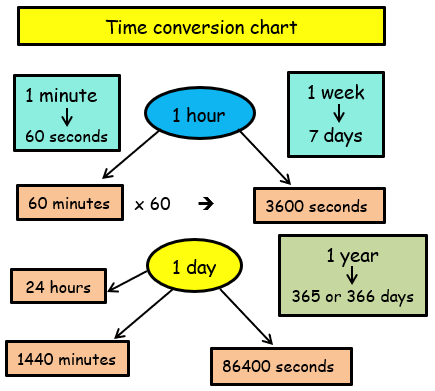
Convert the following into minutes :
Example 1 :
1 hour = 60 minutes
13 hrs = (13 × 60) min
13 hrs = 780 min
Example 2 :
1560 seconds
1 minute = 60 seconds
1560 s = [1560/60] min
1560 s = 26 min
Example 3 :
1 day = 1440 minutes
2 days = (1440 × 2) min
2 days = 2880 min
Example 4 :
6 hours 17 minutes
6 hrs = 360 min
6 hours 17 minutes = (360 + 17) min
6 hours 17 minutes = 377 min
Example 5 :
3 days 5 hours 38 minutes
3 days = (1440 × 3) min
3 days = 4320 min
5 hrs = (60 × 5) min
5 hrs = 300 min
3 days 5 hours 38 minutes = (4320 + 300 + 38) min
3 days 5 hours 38 minutes = 4658 min
Convert the following into days :
Example 6 :
1 year = 365 days
8 years = 2 leap years + 6 years
2 Leap year = (366 × 2) days
2 Leap year = 732 days
6 years = (365 × 6) days
6 years = 2190 days
= (732 + 2190) days
= 2922 days
8 years = 2922 days
Example 7 :
4320 minutes
4320 minutes = (4320/1440) days
4320 min = 3 days
Example 8 :
24 hrs = 1 day
864 hrs = (864/24) days
= 36 days
864 hrs = 36 days
Example 9 :
1 day = 86400 seconds
864000 seconds = (864000/86400) days
= 10 days
864000 s = 10 days
Convert the following into seconds :
Example 10 :
1 hr = 3600 seconds
3 hrs = (3 × 3600) s
3 hrs = 10800 s
Example 11 :
47 min = (47 × 60) s
47 min = 2820 s
Example 12 :
5 hours 7 minutes
1 hour = 3600 seconds
5 hrs = (5 × 3600) s
5 hrs = 18000 s
7 min = (7 × 60) s
7 min = 420 s
5 hours 7 minutes = (18000 + 420) s
5 hours 7 minutes = 18420 s
Example 13 :
7 days = (7 × 86400) s
7 days = 604800 s
1 week = 7 days
1 week = 604800 s
5 weeks = (5 × 604800) s
5 weeks = 3024000 s
Which time period is longer :
Example 14 :
1000 seconds or 16 minutes
1000 s = (1000/60)
1000 s = 16.67 min
16.67 min > 16 minutes
1000 seconds period is longer
Example 15 :
6 hours or 20000 seconds
6 hrs = (6 × 3600) s
6 hrs = 21600 s
21600 s > 20000 s
6 hours period is longer
Example 16 :
2 weeks or 20000 minutes
7 days = (7 × 1440) min
7 days = 10080 min
1 week = 10080 min
2 weeks = 20160 min
20160 min > 20000 min
2 weeks period is longer
Example 17 :
5 days 7 hours or 8000 minutes ?
5 days = (5 × 1440) min
5 days = 7200 min
1 hr = 60 minutes
7 hrs = (7 × 60) min
7 hrs = 420 min
5 days 7 hours = (7200 + 420) min
5 days 7 hours = 7620 min
7620 min < 8000 min
8000 minutes period is longer
Kindly mail your feedback to [email protected]
We always appreciate your feedback.
© All rights reserved. onlinemath4all.com
- Sat Math Practice
- SAT Math Worksheets
- PEMDAS Rule
- BODMAS rule
- GEMDAS Order of Operations
- Math Calculators
- Transformations of Functions
- Order of rotational symmetry
- Lines of symmetry
- Compound Angles
- Quantitative Aptitude Tricks
- Trigonometric ratio table
- Word Problems
- Times Table Shortcuts
- 10th CBSE solution
- PSAT Math Preparation
- Privacy Policy
- Laws of Exponents

Recent Articles
Factorial Problems and Solutions
Oct 24, 24 08:29 PM
SAT Math Resources (Videos, Concepts, Worksheets and More)
Oct 24, 24 11:21 AM
Digital SAT Math Problems and Solutions (Part - 58)
Oct 24, 24 11:17 AM
Converting Units of Time
- Switch to Parent
- Switch to Student

You've reached your daily practice limit of 12 questions.
When you sign up for a free account and login, you can play all you'd like.
(Must be 18 years old to sign up.)
Online Math Activity - Converting Units of Time
Get ready to practice converting units of time with your third grade class! Students will practice converting days to weeks, hours to days, minutes to hours, and so on in this digital math game. Here are a few sample math questions your students may be expected to answer in this telling time activity:
- "Drag and drop the symbol that makes the number sentence true. 300 minutes is [greater than, less than, or equal to] 3 hours."
- "Dayton's baby sister is six weeks old. How many days are in six weeks?"
- "Convert from minutes to hours. [Blank] minutes equals 9 hours."
- "How many minutes are in 2 hours?"
- "Cyrus slept for eight hours last night. How many minutes are in eight hours?"
As students work their way through the math activity, they can count on plenty of handy features to help them make the most out of their math practice session:
- Hint Button - When children get stuck on a question and need a little help, they can click on the Hint Button. The hint consists of a written or pictorial clue that will point children in the right direction without giving away the answer.
- Explanation Page - Students are bound to get an answer wrong every now and then. When they do, a detailed explanation page pops up on the practice screen to show them the correct answer, accompanied by an easy-to-understand explanation to help them learn from mistakes.
- Progress-Tracker - Students can check out the progress-tracker in the upper-right corner of their practice screen to see how many questions they have answered so far out of the total number of questions in the math activity.
- Score-Tracker - Children can view the score-tracker beneath the progress-tracker to see how many points they have earned for correct solutions.
- Speaker Icon - To hear the math question read out loud in a clear voice, students can click on the speaker icon in the upper-left corner of the practice screen. This feature is a great option for ESL/ELL students and children who are auditory processors.
All of these features have been carefully designed to help your third grade students achieve more in their online math practice.
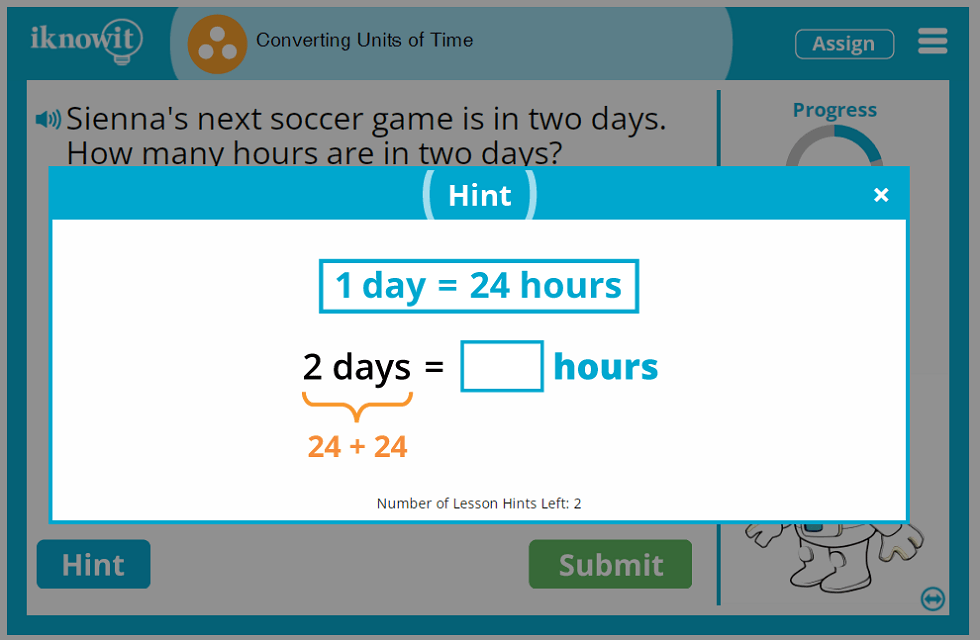
Digital Math Practice Makes Learning Exciting
Give your class a reason to get excited about math practice with interactive math games from I Know It ! Whether you are an elementary math teacher, homeschool educator, or school administrator, we're confident you will love using the I Know It online math program with your students. Check out a few highlights of our program from an educator's perspective:
- Choose from hundreds of math lessons covering dozens of foundational elementary math topics from kindergarten to fifth grade.
- Browse math lessons that have been written by accredited elementary math teachers to meet Common Core Standards.
- Customize your class's math practice experience with comprehensive administrator tools…and more!
Students, too, have lots to love about the I Know It digital math program:
- Adorable, animated characters dance around on the practice screen and do a clever trick when students submit a correct solution to a math problem.
- Plenty of positive feedback messages spur students on in their math practice even when they make mistakes.
- Bright colors and a bold, kid-friendly math lesson format presents each practice session as a fun, yet challenging math game... and more!
We hope you and your students will enjoy converting units of time in this online math lesson. Be sure to browse the hundreds of other 3rd grade elementary skill practice lessons in our collection as well.
Test the Waters or Dive Right In
Looking for a way to "test the waters" and see if the I Know It digital math practice program is right for you and your class? Sign up for a free thirty-day trial and try out this telling time game, as well as all of the math lessons available on our website, at no cost for a full thirty days! We're confident you and your students will love experiencing the difference interactive math practice can make. In fact, when your free trial ends, we hope you won't hesitate to join our community as a member. This way, your class can continue to enjoy the benefits of digital math practice for a full calendar year. We offer membership options for families, individual teachers, schools, and school districts. Visit our membership information page for details: https://www.iknowit.com/order.html .
Your I Know It membership unlocks the program's extensive administrator tools. You will discover a plethora of handy features in your parent or teacher administrator account that help you create a class roster and add your students to it, change basic math lesson settings, monitor student progress with detailed statistics, print, download, and email student progress reports, and much more. These administrator tools serve to help you customize your class's math practice experience.
Your students will log into I Know It with their unique username and password. From a kid-friendly version of the homepage, they can quickly find and launch math activities you have assigned to them for practice. If you choose to give them permission through your parent or teacher administrator account, students can also explore other math activities at their grade level and beyond for additional practice or an extra challenge. Grade levels in the student mode of I Know It are labeled with letters instead of numbers (i.e., "Level C" for third grade), making it easy for you to assign math lessons based on each child's needs and skill level.
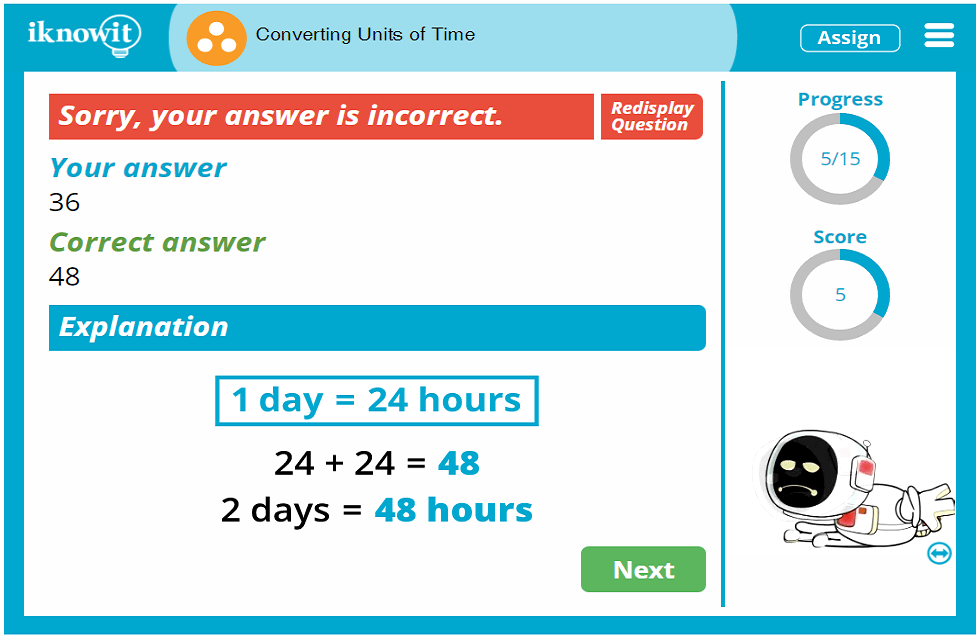
This math lesson is categorized as Level C. It may be ideal for a third grade class.
Common Core Standard
3.MD.1, MA.4.M.1.2, MA.5.M.1.1, 3.7C Measurement And Data Solve Problems Involving Measurement And Estimation Of Intervals Of Time, Liquid Volumes, And Masses Of Objects. Tell and write time to the nearest minute and measure time intervals in minutes. Solve word problems involving addition and subtraction of time intervals in minutes, e.g., by representing the problem on a number line diagram.
You might also be interested in...
Telling Time (Nearest 5 Minutes) (Level C) In this third grade-level math lesson, students will practice telling time to the nearest five minutes. Questions are presented in multiple-choice format and fill-in-the-blank format.
Telling Time (Nearest Minute) (Level C) In this math lesson geared toward third grade, students will practice telling time to the nearest minute. Questions are presented in fill-in-the-blank format and multiple-choice format.

- Full Site Index
- Membership Info
- School License Info
- Standards ( CC , FL , TX )
- Testimonials
- Monthly Contest
- Training for Teachers
- Roster Setup Service
- Privacy Policy
- Terms of Service
Enter your new class code.
Use only letters, numbers or a dash. The code can not begin with a dash (-)
This field is required and can not be blank.
Enter your class code.

Time Calculations Textbook Exercise
Click here for questions, gcse revision cards.

5-a-day Workbooks

Primary Study Cards

Privacy Policy
Terms and Conditions
Corbettmaths © 2012 – 2024

Mixed Units of Time
Nys common core grade 4, module 7, lesson 9.

We welcome your feedback, comments and questions about this site or page. Please submit your feedback or enquiries via our Feedback page.
5th Grade Time Worksheet
In 5th grade time worksheet, students can practice the questions on units for measuring time. The questions are based on convert the time, addition of time, subtraction of time, elapsed time, Word problems on time.
I. Convert the following:
(i) 12 hours to minutes
(ii) 2 hour 15 minutes to seconds
(iii) 5 days to hours
(iv) 4 weeks to days
(v) 25 days to week and days
(vi) 11:35 p.m. to 24 hour clock
(vii) 1640 hours to 12 hour clock
(viii) 2118 hours to 12 hour clock
II. Add the following:
(i) 12 minutes 20 seconds and 32 minutes 25 seconds
(ii) 35 minutes 30 seconds and 13 minutes 50 seconds
(iii) 6 hour 28 minutes 45 seconds and 7 hour 38 minutes 28 seconds
(iv) 62 years 8 months and 7 years 5 months
(v) 13 weeks 2 days and 10 weeks 3 days
III. Subtract the following:
(i) 25 minutes 20 seconds from 37 minutes 50 seconds
(ii) 7 hour 15 minutes from 9 hours
(iii) 14 week 3 days from 16 week 1 day
(iv) 8 years 7 months from 11 years 9 months
IV. Complete the given table:
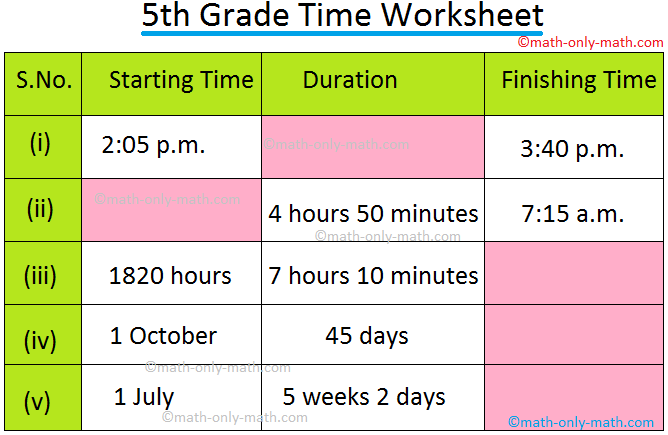
V. Answer the following questions:
(i) Ron is travelling to his home town. He travelled for 4 hours 35 minutes by car, 5 hours 40 minutes by train and 50 minutes by auto-rickshaw. How much time did it take Ron to reach his hometown?
(ii) Fredrick spends 1 hour 30 minutes in gym each day except Sunday which is a holiday. How much time does he spend in the gym in 1 week?
(iii) Rita is 6 years 14 weeks old and his cousin is 6 years 50 days old. Who among them is older and by how much?
I. (i) 720 minutes
(ii) 8100 seconds
(iii) 120 hours
(iv) 28 days
(v) 3 weeks 4 days
(vi) 2335 hours
(vii) 4:40 p.m.
(viii) 9:18 p.m.
II. (i) 44 minutes 45 seconds
(ii) 49 minutes 20 seconds
(iii) 14 hour 7 minutes 13 seconds
(iv) 70 years 1 month
(v) 23 weeks 5 days
III. (i) 12 minutes 30 seconds
(ii) 1 hour 45 minutes
(iii) 1 week 5 days
(iv) 3 years 2 months
IV. (i) 1 hour 35 minutes
(ii) 2:25 a.m.
(iii) 0130 hours
(iv) 14 November
(v) 6 August
V. (i) 11 hours 5 minutes
(ii) 9 hours
(iii) Rita is older, 48 days
5th Grade Numbers Page 5th Grade Math Problems 5th Grade Math Worksheets From 5th Grade Time Worksheet to HOME PAGE
Didn't find what you were looking for? Or want to know more information about Math Only Math . Use this Google Search to find what you need.
New! Comments
Share this page: What’s this?
- Preschool Activities
- Kindergarten Math
- 1st Grade Math
- 2nd Grade Math
- 3rd Grade Math
- 4th Grade Math
- 5th Grade Math
- 6th Grade Math
- 7th Grade Math
- 8th Grade Math
- 9th Grade Math
- 10th Grade Math
- 11 & 12 Grade Math
- Concepts of Sets
- Probability
- Boolean Algebra
- Math Coloring Pages
- Multiplication Table
- Cool Maths Games
- Math Flash Cards
- Online Math Quiz
- Math Puzzles
- Binary System
- Math Dictionary
- Conversion Chart
- Homework Sheets
- Math Problem Ans
- Free Math Answers
- Printable Math Sheet
- Funny Math Answers
- Employment Test
- Math Patterns
- Link Partners
- Privacy Policy

Recent Articles
2nd Grade Multiplication Worksheet | 2-Digit by 1-Digit | 3-Digit by 1
Oct 24, 24 05:23 PM
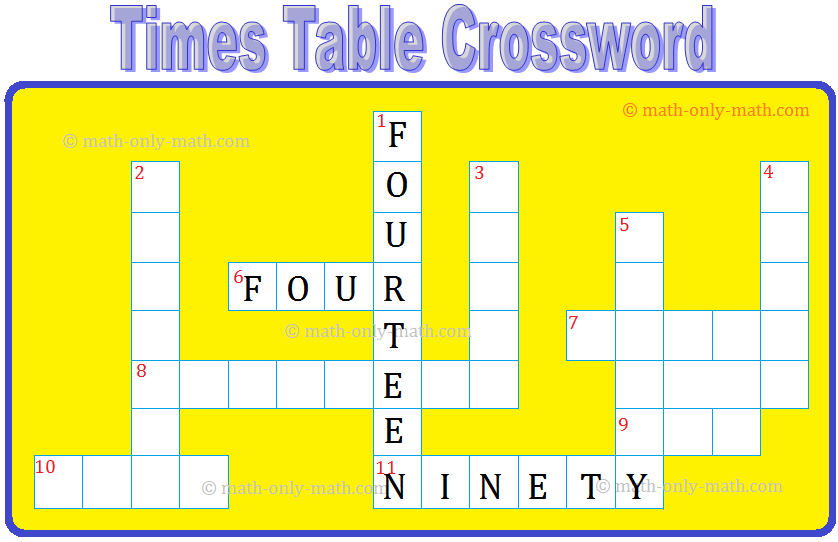
Word Problems on Multiplication |Multiplication Word Problem Worksheet
Oct 23, 24 12:10 PM
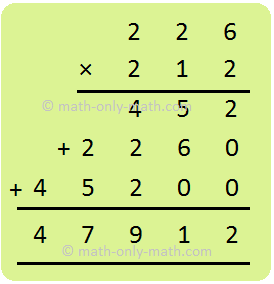
Multiplying 3-Digit Number by 1-Digit Number | Three-Digit Multiplicat
Oct 23, 24 10:15 AM
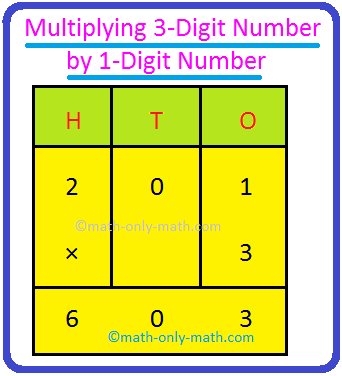
2nd Grade Math Practice | Second Grade Math |2nd Grade Math Worksheets
Oct 23, 24 02:09 AM
Worksheet on Word Problems on Multiplication | Multiplication Problems
Oct 22, 24 12:31 AM
© and ™ math-only-math.com. All Rights Reserved. 2010 - 2024.
- Home |
- About |
- Contact Us |
- Privacy |
- Newsletter |
- Shop |
- 🔍 Search Site
- Halloween Color By Number
- Halloween Dot to Dot
- Kindergarten Halloween Sheets
- 1st Grade Halloween Sheets
- Puzzles & Challenges
- Kindergarten
- All Generated Sheets
- Place Value Generated Sheets
- Addition Generated Sheets
- Subtraction Generated Sheets
- Multiplication Generated Sheets
- Division Generated Sheets
- Money Generated Sheets
- Negative Numbers Generated Sheets
- Fraction Generated Sheets
- Place Value Zones
- Number Bonds
- Addition & Subtraction
- Times Tables
- Fraction & Percent Zones
- All Calculators
- Fraction Calculators
- Percent calculators
- Area & Volume Calculators
- Age Calculator
- Height Calculator
- Roman Numeral Calculator
- Coloring Pages
- Fun Math Sheets
- Math Puzzles
- Mental Math Sheets
- Online Times Tables
- Online Addition & Subtraction
- Math Grab Packs
- All Math Quizzes
- Kindergarten Math Quizzes
- 1st Grade Quizzes
- 2nd Grade Quizzes
- 3rd Grade Quizzes
- 4th Grade Quizzes
- 5th Grade Quizzes
- 6th Grade Math Quizzes
- Place Value
- Rounding Numbers
- Comparing Numbers
- Number Lines
- Prime Numbers
- Negative Numbers
- Roman Numerals
- Subtraction
- Add & Subtract
- Multiplication
- Fraction Worksheets
- Learning Fractions
- Fraction Printables
- Percent Worksheets & Help
- All Geometry
- 2d Shapes Worksheets
- 3d Shapes Worksheets
- Shape Properties
- Geometry Cheat Sheets
- Printable Shapes
- Coordinates
- Measurement
- Math Conversion
- Statistics Worksheets
- Bar Graph Worksheets
- Venn Diagrams
- All Word Problems
- Finding all possibilities
- Logic Problems
- Ratio Word Problems
- All UK Maths Sheets
- Year 1 Maths Worksheets
- Year 2 Maths Worksheets
- Year 3 Maths Worksheets
- Year 4 Maths Worksheets
- Year 5 Maths Worksheets
- Year 6 Maths Worksheets
- All AU Maths Sheets
- Kindergarten Maths Australia
- Year 1 Maths Australia
- Year 2 Maths Australia
- Year 3 Maths Australia
- Year 4 Maths Australia
- Year 5 Maths Australia
- Meet the Sallies
- Certificates
Time Worksheets Hub Page
Welcome to our Time Worksheets hub page.
Here you will find links to a wide range of free printable worksheets about Time, which will help your child become more confident telling the time, adding and subtracting time amounts, converting time and solving time word problems.
For full functionality of this site it is necessary to enable JavaScript.
Here are the instructions how to enable JavaScript in your web browser .
- This page contains links to other Math webpages where you will find a range of activities and resources.
- If you can't find what you are looking for, try searching the site using the Google search box at the top of each page.
Time Worksheets
Quicklinks to ...
- Telling the Time sheets
- Time Conversion
Time Puzzles
- Time Calculators
Telling the Time Worksheets
Here is our collection of telling the time worksheets for kids.
The following worksheets involve children telling the time with an analogue clock, and matching analogue and digital times.
O'clock and Half-past
Here is our selection of telling the time worksheets for 1st grade.
Using these sheets will help your child to:
- read o'clock and half-past times;
- convert o'clock and half-past times to digital;
- draw clock hands correctly to mark out o'clock and half-past.
- Telling Time Worksheets o'clock and half past
Quarter Past and Quarter To
Here are our collection of clock worksheets for 2nd grade. These sheets cover telling the time for quarter past and quarter to times.
Using these second grade math worksheets will help your child to:
- read quarter past and quarter to times;
- convert analogue to digital times;
- draw clock hands in the correct place for quarter past and quarter to.
- Clock Worksheets - Quarter Past and Quarter To
Telling the Time to 5 minutes
This section contains our 3rd grade time worksheets to help children tell the time in multiples of 5 minutes.
Using the sheets in this section will help your child to:
- tell the time to the nearest 5 minutes;
- become familiar with both digital and analogue times;
- add and subtract time intervals;
- use the words 'past' and 'to' to describe the time correctly.
These 3rd grade time worksheets will help your child become more familiar with telling the time.
- Telling Time to 5 Minutes Worksheets
Telling the Time to 1 minute
This section contains our 4th grade time worksheets to help children tell the time to the nearest minute.
- tell the time to the nearest minute;
- add and subtract time intervals.
These 4th grade time worksheets will help your child become more familiar with telling the time.
- Telling Time Worksheets Grade 4 (1 minute intervals)
Top of Page
Converting Time
- 24 Hour Clock Conversion Worksheets
On this webpage there is a selection of printable 24 hour (military time) conversion worksheets which will help you learn to convert from 24 hour clock to standard 12 hour time, and from standard time to 24 hour time.
An answer sheet is provided with each sheet and the sheets are graded with the easiest sheets coming with supporting information.
Time Interval Worksheets
These sheets will help you learn to add and subtract hours and minutes from times as well as working out a range of time intervals.
There are also sheets to help you practice adding and subtracting time intervals.
- Add and Subtract Time Worksheets
- Elapsed Time Worksheets
Looking for an extension activity for children who can already tell the time?
Maybe you want an interesting starter activity for your lesson to get the class thinking?
These printable time puzzles will help to get your child thinking about time and solving problems involving time.
They are good at developing an understanding of the language used in time.
- Printable Time Worksheets - Time Puzzles (easier)
- Time Word Problems Worksheets - Harder Riddles
Time Conversion Calculators
Our time calculators will allow you to convert any digital time into a military time, and back.
We also have a decimal time converter which will take a time in hours, minutes and seconds and then convert it to a decimal number which represents that time. This calculator will also take a decimal time and convert it to hours, minutes and seconds.
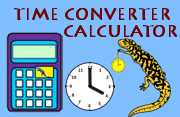
- Units of Time Converter
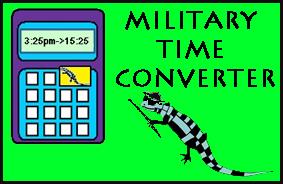
- Online Military Time Converter
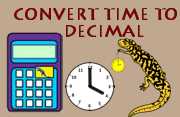
- Convert Time to Decimal
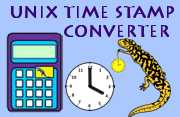
- Unix Time Stamp Converter
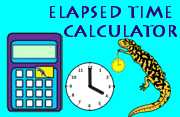
- Elapsed Time Calculator
More Time Calculators
- convert hours to seconds
- hours and minutes calculator
How to Print or Save these sheets 🖶
Need help with printing or saving? Follow these 3 steps to get your worksheets printed perfectly!
- How to Print support
Subscribe to Math Salamanders News
Sign up for our newsletter to get free math support delivered to your inbox each month. Plus, get a seasonal math grab pack included for free!

- Newsletter Signup
Return from Money Printable Worksheets to Math Salamanders Homepage
Math-Salamanders.com
The Math Salamanders hope you enjoy using these free printable Math worksheets and all our other Math games and resources.
We welcome any comments about our site or worksheets on the Facebook comments box at the bottom of every page.
New! Comments
TOP OF PAGE
© 2010-2024 Math Salamanders Limited. All Rights Reserved.
- Privacy Policy
- Copyright Policy
You'll need JavaScript enabled to experience the full functionality of this site. Please enable JavaScript by following the instructions at enable-javascript.com .
Sorry, the browser you're currently using is not supported by this site. Please upgrade your browser by following the instructions at browser-update.org .

Converting Units of Time — Problem Solving (Year 5)
Write a review

Choose your format:
Save to Your Lessons
Save to Homework
Share resource
Your download limit has been reached!
Check out our FAQs for more info.
Children will recap how to convert between different units of time with this PowerPoint. In the first part, they focus on converting from larger to smaller units of time by using multiplication, whilst in the second part they focus on the inverse. There are also two mini quizzes to test children's learning.
- Key Stage: Key Stage 2
- Subject: Maths
- Topic: Time
- Topic Group: Measurement
- Year(s): Year 5
- Media Type: PowerPoint
- Resource Type: PowerPoint
- Last Updated: 28/09/2022
- Resource Code: M2PAC1442
- Curriculum Point(s): Solve problems involving converting between units of time.
Related Topics:
Other Teachers Downloaded...

Converting Between Units of Time (Year 5)
- Key Stage 2 Maths

Time Conversions (Year 5)


Tick Tock! Time Conversion Word Problems (Year 5)

Converting Units of Time (Year 5)

Time Conversion (Year 5)

Making Inferences — Treasure Island (Years 5-6)
- Making Inferences
- Key Stage 2 English
No reviews (yet!)
Related Resources

Tick Tock! Time Conversions (Year 5)

Tick Tock! Quiz — Converting Between Units of Time (Year 5)

Comparing Lengths of Time (Year 3)

Converting Units of Time — Word Problems (Year 5)

Units for Measuring Time (Year 3)

Minutes and Seconds — Worksheet (Year 3)

Units of Time Problems: Foundation (Year 3)

Units of Time Problems (Year 3)
Cookies are disabled on your browser. This means some features of the site won't be fully available to you.
CGP uses cookies to give you a smooth shopping experience and to help us understand how well our site is working. To agree to us using all cookies, click 'Accept', or to reject optional cookies click 'Customise'.
Accept cookies Customise cookies
Mastery-Aligned Maths Tutoring
“The best thing has been the increase in confidence and tutors being there to deal with any misunderstandings straight away."
FREE daily maths challenges
A new KS2 maths challenge every day. Perfect as lesson starters - no prep required!

25 Time Word Problems for Year 2 to Year 6 With Tips On Supporting Pupils’ Progress
Emma Johnson
Time word problems are an important element of teaching children how to tell the time. Children are introduced to the concept of time in Year 1. At this early stage, they learn the basics of analogue time; reading to the hour and half past and learn how to draw hands on the clocks to show these times.
As they move through primary school, pupils progress onto reading the time in analogue, digital and 24 hour clocks and being able to compare the duration of events. By the time children reach upper Key Stage 2, they should be confident in reading the time in all formats and solving problems involving converting between units of time.
Time in Year 1
Time in year 2, time in year 3, time in year 4, time in year 5 & 6.
- Why are word problems important for children’s understanding of time
How to teach time word problem solving in primary school
Time word problems for year 2, time word problems for year 3, time word problems for year 4, time word problems for year 5, time word problems for year 6, more time and word problems resources.
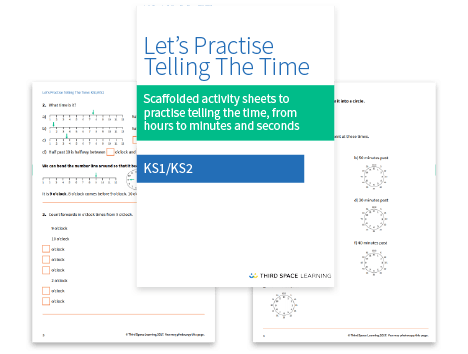
Let's Practice Telling The Time
Download this free printable worksheet to let your students practice telling the time.
When students are first introduced to time and time word problems , it is important for them to have physical clocks, to hold and manipulate the hands. Pictures on worksheets are helpful, but physical clocks enable them to work out what is happening with the hands and to solve word problems involving addition word problems and subtraction word problems .
Time word problems are important for helping children to understand how time is used in the real-world. We have put together a collection of 25 time word problems, which can be used with pupils from Year 2 to Year 6.
Time word problems in the National Curriculum
In Year 1, students are introduced to the basics of time. They learn to recognise the hour and minute hand and use this to help read the time to the hour and half past the hour. They also draw hands on clock faces to represent these times.
By the end of Year 2, pupils should be able to tell the time to five minutes, including quarter past/to the hour and draw the hands on a clock face to show these times. They should also know the number of minutes in an hour and the number of hours in a day.
In Year 3, children read the time in analogue (including using Roman Numerals). By this stage they are also learning to read digital time in 12 and 24 hour clock, using the AM and PM suffixes. Pupils record and compare time in terms of seconds, minutes and hours; know the number of seconds in a minute, days in a month and year and compare durations of events.
By Year 4, pupils should be confident telling the time in analogue to the nearest minute, digital and 24 hour clock. They also need to be able to read, write and convert time between analogue and digital 12 and 24 hour clocks and solve problems involving converting from hours to minutes; minutes to seconds; years to months and weeks to days.
By Year 5 and 6, there is only limited mention of time in the curriculum. Pupils continue to build on the knowledge they have picked up so far and should be confident telling the time and solving a range of problems, including: converting units of time; elapsed time word problems, working with timetables and tackling multi-step word problems .
Time word problems have been known to appear on Year 6 SATs tests. Third Space Learning’s online one-to-one SATs revision programme incorporates a wide range of word problems to develop students’ problem solving skills and prepare them the SATs tests. Available for all primary year groups as well as Year 7 and GCSE, our online tuition programmes are personalised to suit the needs of each individual student, fill learning gaps and build confidence in maths.
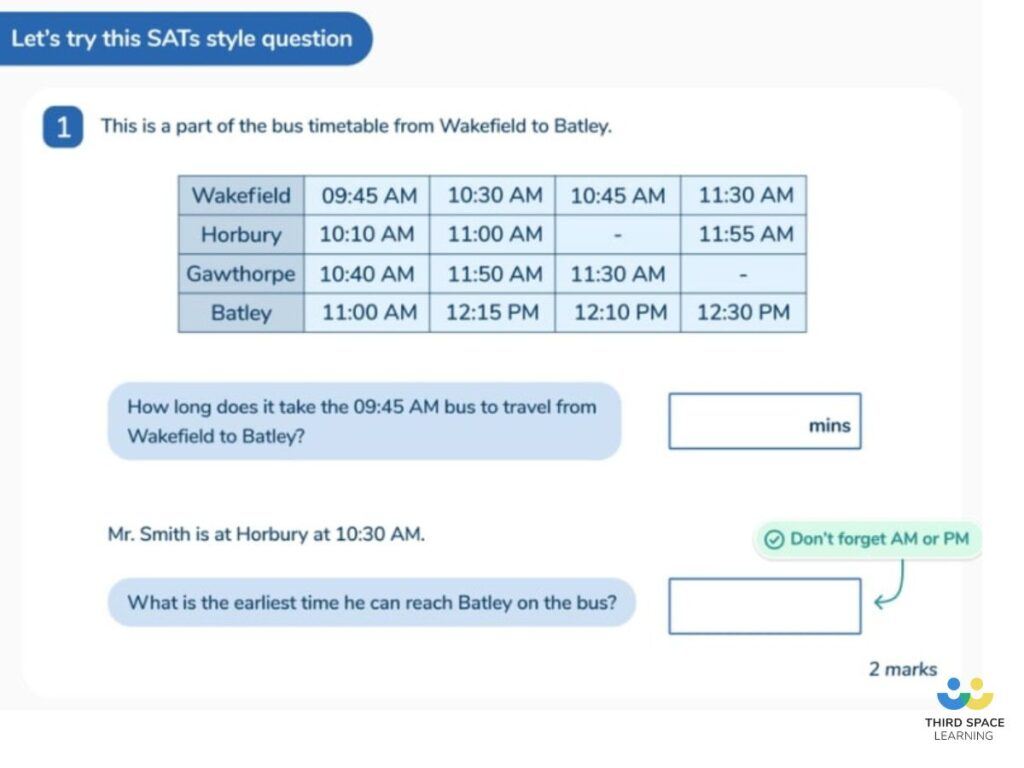
Why are word problems important for children’s understanding of time
Word problems are important for helping children to develop their understanding of time and the different ways time is used on an every-day basis. Confidence in telling the time and solving a range of time problems is a key life skill. Time word problems provide children with the opportunity to build on the skills they have picked up and apply them to real-world situations.
It’s important children learn the skills needed to solve word problems. Key things they need to remember are: to make sure they read the question carefully; to think whether they have fully understood what is being asked and then identify what they will need to do to solve the problem and whether there are any concrete resources or pictorial representations which will help them.
Here is an example:
Mr Arrowsmith drives to Birmingham. He sets off at 3:15pm. He stops for a break of 15 minutes at 4:50 and arrives in Birmingham at 6:15pm.
How long did Mr Arrowsmith spend driving?
How to solve:
What do you already know?
- We know that he set off at 3:15pm and stopped for a break at 4:50. We can calculate how long the first part of his journey was, by counting on from 3:15 to 4:50.
- He had a break at 4:50pm for 15 minutes, so we won’t include that in our driving time calculation.
- He then must have set off again at 5:05pm, before arriving at 6:15pm. We can use this information to work out the length of the second part of his journey.
- We can then add the 2 journey times together, to calculate the total amount of time spent driving.
How can this be represented pictorially?
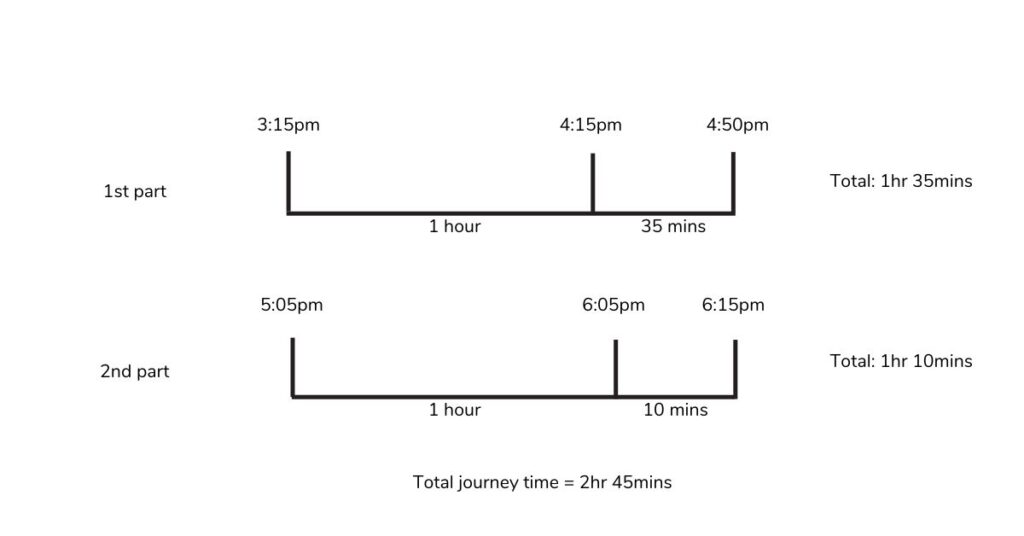
- We can use a number line to calculate the length of time each journey takes.
- If we start by adding on an hour, we can then calculate how many more minutes for each section of the journey.
- Once we have calculated the journey time for each part of the journey, we can add these together to calculate the total journey time.
Time word problems in Year 2 require students to read the time to o’clock and half past the hour and compare and sequence time intervals.
Oliver went for a bike ride with his friend.
He left home at 2 o’clock and came home at 4 o’clock.
How long was he out on his bike for?
Answer: 2 hours
Count on from 2 o’ clock to 4 o’clock or subtract 2 from 4.
Mum went shopping at 3 o’clock and got home an hour later.
Draw the time she got home on the clock below.

Tom baked a cake.
The cake was in the oven for one hour.
If he took the cake out at half past 11, what time did he put the cake in?
Answer: Half past 10
Use an hour from half past 11.
Arlo starts school at 9 o’clock and has his first break at half past 10.
How long does he have to wait for his first break?
Answer: One and a half hours.
(Use a number line to count on from 9 to half past 10)
The Smith family are going to the beach.
They plan to leave home at 10 o’clock and the journey take two hours.
What time will they arrive at the beach?
Answer: 12 o’clock
(Use a number line to count on 2 hours from 10 o’clock)
With time word problems for year 3 , students build on their understanding of analogue time from Year 2 and also begin to read the time in digital (12 and 24 hour clock). Children also need to be able to compare time and durations of events.
Chloe is walking to football training.
She sets off at 8:40am and takes 17 minutes to get there.
What time does she arrive?
Answer: 8:57
(Count on 17 minutes from 8:40 – use a number line if needed)
(Picture of analogue clock with 2:30 showing here)
Maisie says that in 1 hour and 48 minutes it will be 4:28.
Do you agree? Explain how you worked out your answer.
Answer: Maisie is wrong. It will be 4:18.
This can be worked out by counting on an hour from 2:30 to 3:30 and then another 48 minutes to 4:18.
The Baker family are driving to their campsite.
They set off at 8:30 am, drive for 2 hours and 15 minutes, then had a 30 minute break.
If they drive for another 1 hour and 45 minutes, what time do they arrive at the campsite?
Answer: 12:45pm
Use a number line to show what time they arrive at the break. From 8:30, count on 2 hours and 15 minutes to get to 10:45. Add on the 30 minute break. It is now 11:15. They count on another hour and a half to 12:45
Ahmed looks at his watch and says ‘it is half past 4 in the afternoon’
Jude says that it is 17:30 in a 24 hour clock.
Is Jude correct? Explain your answer.
Answer: Jude is not correct. Half past 4 in the afternoon is 16:30 not 17:30
How many minutes are there in 2 hours and 30 minutes?
Answer: 150 minutes
60 + 60 + 30 = 150
When solving time word problems for year 4 , pupils need to be confident telling time in analogue, and digital, as well as converting between analogue, 12 hour and 24 hour clock. They also begin to solve more challenging problems involving duration of time and converting time.
If there are 60 seconds in 1 minute. How many seconds are there in 8 minutes?
Answer: 480 seconds
60 x 8 = 480 seconds (calculate 6 x 8, then multiply by 10)
Mason played on his VR from 3:35 to 5:25.
How long did he play on his VR?
Answer: 1 hour and 50 minutes.
Count on from 3:35 (using a numberline if needed)
Jamie started his homework at 3:45pm. He finished 43 minutes later.
What time did Jamie finish? Give your answer in 24 hour clock.
Answer: 16:28
Count on 43 minutes from 3:45 (use a number line, if needed) = 4:28. Convert to 24 hour clock.
Chloe and Freya went to the cinema to watch a film. The film started at 2:05pm and lasted for 1 hour and 43 minutes.
What time did the film end?
Answer: 3:48pm
Count on one hour from 2:05 pm to 3:05pm, then add another 43 minutes – 3:48pm
A family is driving on their holiday.
They drive for 2 hours and 28 minutes, stop for 28 minutes and then drive a further 1 hour and 52 minutes.
If they left at 8:30am, what time did they arrive?
Answer: 1:18pm
2 hours and 28 minutes from 8:30am = 10:58am
10:58am with a 28 minute break = 11:26am
1 hour 52 minute drive from 11:26 am = 1:18pm
With word problems for year 5 , pupils should be confident telling the time in analogue and digital and solving a wider range of time problems including: converting units of time; interpreting and answering questions on timetables and elapsed time.
The sun set at 19:31 and rose again at 6:28.
How many hours passed between the sun setting and rising again?
Answer: 10 hours and 57 minutes
Count on from 19:31 to 5:31 (10 hours)
Then count on from 5:31 to 6:28 (57 minutes)
A play started at 14:45 and finished at 16:58.
How long was the play?
Answer: 2 hours and 13 minutes
Count on 2 hours from 14:45 to 16:45, then add another 13 minutes to get to 16:58
How many seconds are there in 23 minutes?
Answer: 1380 seconds
Show as column method: 60 x 23 = 1380
Max ran a race in 2 minutes 13 seconds, Oscar ran it in 125 seconds.
What was the difference in time between Max and Oscar?
Answer: Oscar was 8 seconds faster.
Max – 2 minutes 13 seconds, Oscar – 2 minutes 5 seconds (difference of 8 seconds)
4 children take part in a freestyle swimming relay.
There times were:
Maisie: 42.8 seconds
Amber 36.3 seconds
Megan 48.7 seconds
Zymal 45.6 seconds
What was the final time for the relay in minutes and seconds?
Answer: 2:53.4
(Show as column method) 42.8 + 36.3 + 48.7 + 45.6 = 173.4 seconds
173.4 seconds = 2:53.4
No new time concepts are taught to pupils in word problems for year 6 . By this stage they are continuing to build confidence and develop skills within the concepts already taught.
Chess: 25 minutes
Basketball: 40 minutes.
Trampolining: 30 minutes
Gymnastics: 50 minutes
Tennis 40 minutes
Tri golf – 45 minutes
Hamza is choosing activities to take part in at his holiday club.
The activities can’t add up to more than 2 hours.
Which 3 activities could he do, which add up to exactly 2 hours?
Answer: Trampolining, gymnastics and tennis: Trampolining: 30 minutes, gymnastics: 50 minutes, tennis: 40 minutes.
5 children took part in a sponsored swim. The children swam for the following lengths of time:
Sam: 27 minutes 37 seconds
Jemma: 33 minutes 29 seconds.
Ben: 23 minutes 18 seconds
Lucy: 41 minutes 57 seconds
Oliver: 39 minutes 21 seconds
Answer: 18 minutes 30 seconds
Longest: Lucy: 41 minutes 57 seconds
Shortest: Ben: 23 minutes 18 seconds.
Difference – count up from 23 minutes 18 seconds to 41 minutes 57 seconds = 18 minutes 39 seconds
What is 6 minutes 47 seconds in seconds?
Answer: 407 minutes
60 x 6 = 360
360 + 47 = 407 minutes
Bethany’s goal is to run round her school running track in under 8 minutes.
She runs it in 440 seconds. Does she achieve her goal? How far above or below the target is she?
Answer: Bethany beats her target by 40 seconds
8 minutes = 8 x 60 = 480 minutes
Lucy’s favourite programme is on TV twice a week for 35 minutes.
In 6 weeks, how many hours does Lucy spend watching her favourite programme?
Answer: 7 hours
420 minutes = 7 hours
(Show as column method) 35 x 12 = 420 minutes
420 ÷ 60 = 7
For more time resources, take a look at our collection of printable time worksheets. Third Space Learning also offers a wide collection of word problems covering a range of topics such as place value, decimals and fractions word problems , percentages word problems , division word problems , ratio word problems , addition and subtraction word problems , multiplication word problems , money word problems and other word problem challenge cards.
DO YOU HAVE STUDENTS WHO NEED MORE SUPPORT IN MATHS?
Every week Third Space Learning’s specialist primary maths tutors support thousands of students across hundreds of schools with weekly online 1 to 1 maths lessons designed to plug gaps and boost progress.
Since 2013 these personalised one to one lessons have helped over 169,000 primary and secondary students become more confident, able mathematicians.
Learn how tutors develop pupils’ maths fluency or request a personalised quote for your school to speak to us about your school’s needs and how we can help.
Related articles

Maths Problem Solving: Engaging Your Students And Strengthening Their Mathematical Skills
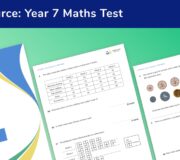
Free Year 7 Maths Test With Answers And Mark Scheme: Mixed Topic Questions

What Is A Number Square? Explained For Primary School Teachers, Parents & Pupils
What Is Numicon? Explained For Primary School Teachers, Parents And Pupils
FREE Guide to Maths Mastery
All you need to know to successfully implement a mastery approach to mathematics in your primary school, at whatever stage of your journey.
Ideal for running staff meetings on mastery or sense checking your own approach to mastery.
Privacy Overview

Reading & Math for K-5
- Kindergarten
- Learning numbers
- Comparing numbers
- Place Value
- Roman numerals
- Subtraction
- Multiplication
- Order of operations
- Drills & practice
- Measurement
- Factoring & prime factors
- Proportions
- Shape & geometry
- Data & graphing
- Word problems
- Children's stories
- Leveled stories
- Sight words
- Sentences & passages
- Context clues
- Cause & effect
- Compare & contrast
- Fact vs. fiction
- Fact vs. opinion
- Main idea & details
- Story elements
- Conclusions & inferences
- Sounds & phonics
- Words & vocabulary
- Reading comprehension
- Early writing
- Numbers & counting
- Simple math
- Social skills
- Other activities
- Dolch sight words
- Fry sight words
- Multiple meaning words
- Prefixes & suffixes
- Vocabulary cards
- Other parts of speech
- Punctuation
- Capitalization
- Narrative writing
- Opinion writing
- Informative writing
- Cursive alphabet
- Cursive letters
- Cursive letter joins
- Cursive words
- Cursive sentences
- Cursive passages
- Grammar & Writing
Breadcrumbs
- Word Problems
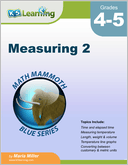
Download & Print Only $7.70
Time word problems
Word problem worksheets: time and elapsed time.
Below are three versions of our grade 4 math worksheet with word problems involving time and elapsed time. Students must figure out what time it was, will be or how much time went by in the various scenarios described. Use of "am" and "pm" is emphasized. These worksheets are pdf files .

These worksheets are available to members only.
Join K5 to save time, skip ads and access more content. Learn More
More word problem worksheets
Explore all of our math word problem worksheets , from kindergarten through grade 5.
What is K5?
K5 Learning offers free worksheets , flashcards and inexpensive workbooks for kids in kindergarten to grade 5. Become a member to access additional content and skip ads.
Our members helped us give away millions of worksheets last year.
We provide free educational materials to parents and teachers in over 100 countries. If you can, please consider purchasing a membership ($24/year) to support our efforts.
Members skip ads and access exclusive features.
Learn about member benefits
This content is available to members only.
Filter year:
Units of Time Reasoning and Problem Solving

If the idea of six quality reasoning and problem-solving questions designed to get your class applying their understanding of time sounds good to you, download this Year 3 Units of Time worksheet! It can be done at school or at home, and comes with a handy answer sheet to save you time when it comes to marking. You could even pass the answers to your children and get them to self- and peer-mark. It's up to you!
Curriculum Objectives
- Estimate and read time with increasing accuracy to the nearest minute; record and compare time in terms of seconds, minutes and hours; use vocabulary such as o’clock, a.m./p.m., morning, afternoon, noon and midnight
- Know the number of seconds in a minute and the number of days in each month, year and leap year
- Compare durations of events [for example to calculate the time taken by particular events or tasks]
Measurement
More like this

More Y3 resources
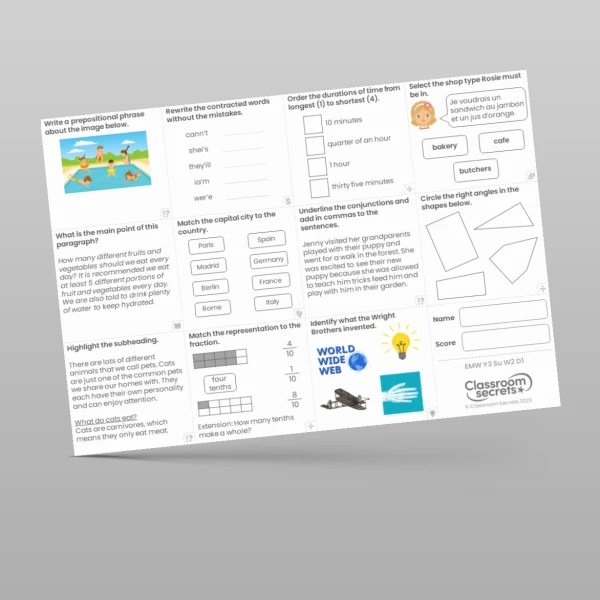

NAHB’s Blueprint to Address the Housing Affordability Crisis
A 10-point housing plan.
With a nationwide shortage of roughly 1.5 million housing units that is making it increasingly difficult for American families to afford to purchase or rent a home, NAHB provides this 10-point housing plan to help tame shelter inflation and ease the housing affordability crisis by removing barriers that hinder the construction of new homes and apartments.
Shelter inflation — rent and homeownership costs — is still rising well above a 5% rate, and for the past year, more than half of overall inflation in the economy has been due to rising housing costs. The only way to effectively tame shelter inflation – particularly with elevated interest rates for both mortgages and development/construction loans — is to build more attainable, affordable housing.
With policymakers at all levels of government looking for ways to provide more affordable homeownership and rental housing opportunities for all Americans, NAHB is offering a plan that outlines initiatives that can be taken at the local, state and federal levels to address the root of the problem — the impediments to increasing the nation’s housing supply.
- Eliminate excessive regulations;
- Promote careers in the skilled trades;
- Fix building material supply chains and ease costs;
- Pass federal tax legislation to expand the production of affordable and attainable housing;
- Overturn inefficient local zoning rules;
- Alleviate permitting roadblocks;
- Adopt reasonable and cost-effective building codes;
- Reduce local impact fees and other upfront taxes associated with housing construction;
- Make it easier for developers to finance new housing; and
- Update employment policies to promote flexibility and opportunity.
NAHB delves further into these issues below.
Access a PDF of the 10-point plan.
Resources exclusively for state and local associations related to NAHB’s Housing Plan.

Eliminate Excessive Regulations
Regulations account for nearly 25% of the cost of a single-family home and more than 40% of the cost of a typical apartment development. Policies at all levels of government are needed to ensure agencies consider the true effect of regulations on small businesses.

Promote Careers in Skilled Trades
There’s a monthly shortage of nearly 400,000 construction workers, and builders will need to add 2.2 million new workers over the next three years to keep up with demand. Policymakers should support funding for construction trades education and provide more placement services to job seekers.

Fix Building Material Supply Chains
The cost of building materials has surged 38% since the pandemic. Of particular concern, the price of distribution transformers is up 72%, and along with a severe shortage of transformers, this is delaying housing projects across the nation.

Pass Federal Tax Legislation to Expand Production of Affordable and Attainable Housing
The Affordable Housing Credit Improvement Act would expand the Low-Income Housing Tax Credit and enable builders to increase production of badly needed affordable housing.

Overturn Inefficient Zoning Rules
Inefficient land use policies make it harder and more expensive to build. Localities need to rework ineffective zoning plans, and provide more options, such as reducing minimum lot sizes, allowing more accessory dwelling units and promoting missing middle housing (e.g., townhomes and duplexes).

Alleviate Permitting Roadblocks
Permitting delays at all levels of government delay housing projects and raise construction costs. Localities need to make it a priority to avoid needless bottlenecks in their approval processes. One easy solution is a time limit on how long the government has to either approve or deny a permit.

Adopt Reasonable and Cost-Effective Building Codes
Studies have shown that building to the 2021 IECC can add as much as $31,000 to the price of a new home and require up to 90 years for a home buyer to realize a payback. That’s not a reasonable trade-off and would not provide meaningful energy savings.

Reduce Local Impact Fees and Other Upfront Taxes
The home building industry agrees that some impact fees are necessary to cover the costs of increased public services for new home developments. However, lawmakers must impose impact fees fairly with the cost to the home buyer in mind.

Make it Easier for Developers to Finance New Housing
Fannie Mae, Freddie Mac and the Federal Home Loan Banks should be encouraged to support a secondary market for AD&C financing that would expand financing options for builders to increase the housing supply.

Update Employment Policies to Promote Flexibility
The current patchwork approach for builders to determine worker status, calculating overtime pay and prevailing wages creates, and documenting employment status creates unnecessary burdens and disincentivizes housing production.

Top Priorities
Tackling the affordability crisis and the key issues that must be addressed to ensure a robust housing market.

Industry News
Get the latest updates on key developments in the housing industry.
Latest news

Industry Issues
NAHB is the leading voice for the housing industry on the wide range of issues that impact home building.
More information
The NAHB website uses cookies. We do this to provide a personalized experience, improve our content, and monitor the site performance. By clicking Accept you consent to NAHB’s use of cookies in accordance with its Privacy Policy . To learn more and control what cookies are used, go to Manage Cookies .

IMAGES
VIDEO
COMMENTS
Converting units of time is converting between seconds, minutes and hours. To convert units of measurement, you need to first understand the relationships between the units and use the correct time conversion factor. ... and use these conversions in solving multi-step, real world problems. Grade 6: Ratios and Proportional Relationships (6.RP.A.3d)
440 hours. Q4. From the list of people below, who has worked the most amount of hours? A works 8 hour shifts, five times a week. B works 12 hour shifts, three times a week. C works 9 hour shifts, four times a week. D works 6 hour shifts, six times a week. Q5. Anna has been training for a marathon.
Lesson outcome. In this lesson, we will solve word problems which compare different units of time. Introduction. Prepare. Starter quiz. Activate - 5 Questions. Lesson video. Learn. Exit quiz.
Questions 3, 6 and 9 (Problem Solving) Developing Convert 3 units of time with no remainders to solve word problems. Expected Convert 3 units of time with remainders to solve word problems. Greater Depth Non-direct conversion of 4 units of time with remainders and decimals to solve word problems. More Year 4 and Year 5 Converting Units resources.
Check the units involved. Show step. 11 hour = 60= 60 minutes. So the conversion factor is 60.60. Multiply or divide by the conversion factor. Show step. We need to concentrate on the decimal part of the original number, 0.4. 0.4. We multiply by 6060 to convert to minutes. 0.4 × 60 = 240.4 × 60 = 24.
CONVERSION OF UNITS OF TIME PRACTICE PROBLEMS. Convert the following into minutes : Example 1 : 13 hours. Solution : 1 hour = 60 minutes. 13 hrs = (13 × 60) min. ... Solving Exponential Equations Problems and Solutions (Part - 6) Oct 21, 24 03:23 AM. Solving Exponential Equations Problems and Solutions (Part - 6) Read More.
Online Math Activity - Converting Units of Time. Get ready to practice converting units of time with your third grade class! Students will practice converting days to weeks, hours to days, minutes to hours, and so on in this digital math game. Here are a few sample math questions your students may be expected to answer in this telling time ...
These grade 3 time worksheets give students practice in converting units of time between seconds, minutes, hours, days, weeks and years. Minutes & seconds: Worksheet #1. Hours & minutes: Worksheet #2. Hours & seconds: Worksheet #3. Hours & days:
The Corbettmaths Textbook Exercise on Time Calculations. Next: Product Rule for Counting Practice Questions
Examples, solutions, and videos to help Grade 4 students learn how to solve problems involving mixed units of time. Topic B: Problem Solving with Measurement Common Core Standards: 4.OA.2, 4.OA.3, 4.MD.1, 4.MD.2, 4.NBT.5, 4.NBT.6 NYS Common Core Grade 4, Module 7, Lesson 9 Worksheets for Grade 4 Lesson 9 Problem Set
5th Grade Time Worksheet. In 5th grade time worksheet, students can practice the questions on units for measuring time. The questions are based on convert the time, addition of time, subtraction of time, elapsed time, Word problems on time. I. Convert the following: (i) 12 hours to minutes. (ii) 2 hour 15 minutes to seconds. (iii) 5 days to hours.
Solving Problems Involving Converting Time Answers question answer 1 8 hours 33 minutes 2 194 minutes 3 337 seconds 4 6 hours and 26 minutes 5 5 years and 5 months 6 95 months 7 12 weeks and 2 days 8 131 days 9 319 seconds is more than 300 seconds (5 minutes). 10 175 days 11 43 hours and 45 minutes 12 3 years 6 months
Convert among different-sized standard measurement units within a given measurement system (e.g., convert 5 cm to 0.05 m), and use these conversions in solving multi-step, real world problems. Grade 5 Standards for Mathematical Practice Measurement & Data Convert like measurement units within a given measurement system Math 4.8(B)
Here are our collection of clock worksheets for 2nd grade. These sheets cover telling the time for quarter past and quarter to times. Using these second grade math worksheets will help your child to: read quarter past and quarter to times; convert analogue to digital times; draw clock hands in the correct place for quarter past and quarter to.
Develop problem solving skills set of printable multi-step time conversion worksheets. This set of problem solving questions has been designed to support teachers when teaching students about converting units of time. It provides students with the opportunity to work through 12 maths word problems identifying the relevant units and how they can ...
This Year 5 Convert Units of Time resource is a fantastic way to get your children thinking deeper around the subject of converting units of time. It is made up of six reasoning and problem-solving questions, that have been differentiated three ways to allow access and challenge across the whole of your Year 5 classroom.
Children will recap how to convert between different units of time with this PowerPoint. In the first part, they focus on converting from larger to smaller units of time by using multiplication, whilst in the second part they focus on the inverse. There are also two mini quizzes to test children's learning. Key Stage: Key Stage 2. Subject: Maths.
Pupils continue to build on the knowledge they have picked up so far and should be confident telling the time and solving a range of problems, including: converting units of time; elapsed time word problems, working with timetables and tackling multi-step word problems. Time word problems have been known to appear on Year 6 SATs tests.
Time Word Problem Loop Cards. Year 3 Time Maths Mastery - Word Problem Challenge Cards. 4.6 (11 reviews) Sonic: Time Challenge Cards [Ages 7-9] 5.0 (4 reviews) KS2 The Year 3000 Calendar - Maths Mastery Problems. Sonic: Time Challenges [Ages 9-11] 4.9 (7 reviews) Scuderia Ferrari F1: Time Problems Interactive Quiz.
Below are three versions of our grade 4 math worksheet with word problems involving time and elapsed time. Students must figure out what time it was, will be or how much time went by in the various scenarios described. Use of "am" and "pm" is emphasized. These worksheets are pdf files. Worksheet #1 Worksheet #2 Worksheet #3 Worksheet #4.
If the idea of six quality reasoning and problem-solving questions designed to get your class applying their understanding of time sounds good to you, download this Year 3 Units of Time worksheet! It can be done at school or at home, and comes with a handy answer sheet to save you time when it comes to marking.
With a nationwide shortage of roughly 1.5 million housing units that is making it increasingly difficult for American families to afford to purchase or rent a home, NAHB provides this 10-point housing plan to help tame shelter inflation and ease the housing affordability crisis by removing barriers that hinder the construction of new homes and apartments.